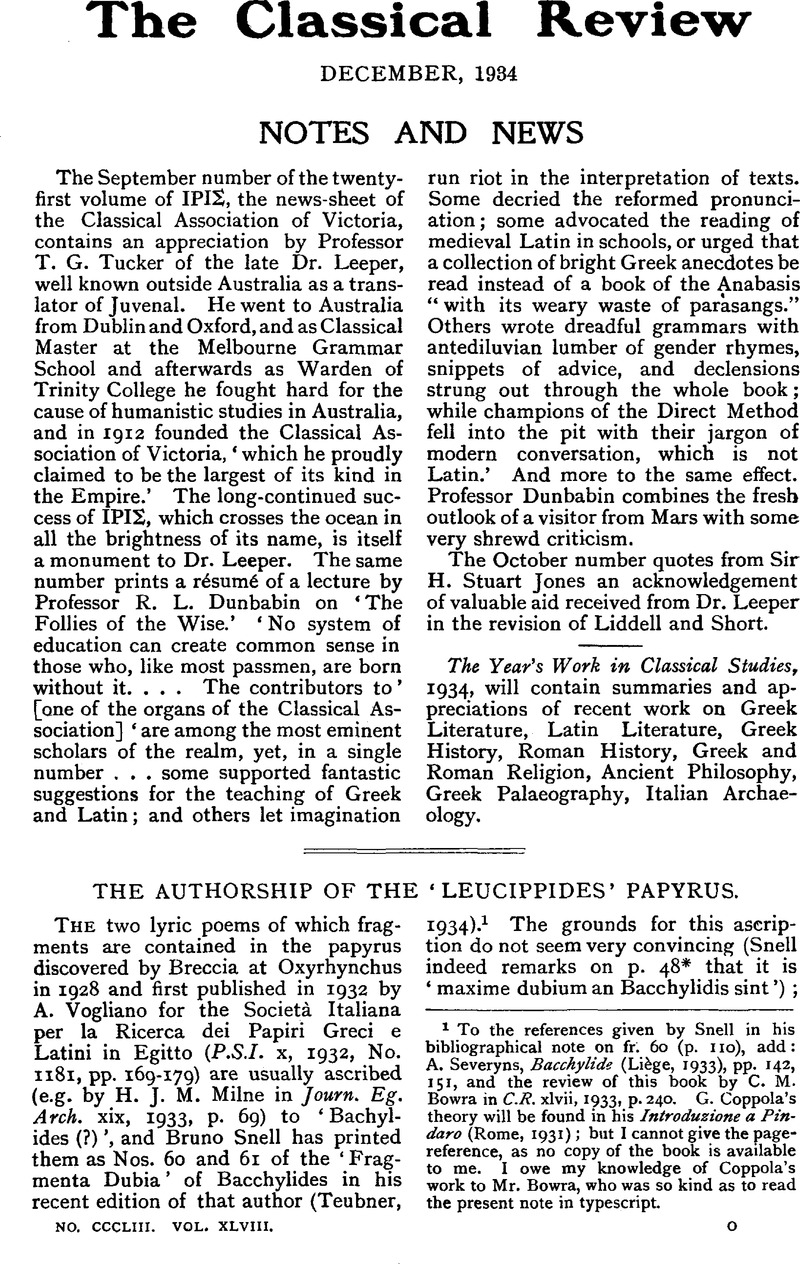No CrossRef data available.
Published online by Cambridge University Press: 27 October 2009

page 205 note 1 To the references given by Snell in his bibliographical note on fr. 60 (p. 110), add: Severyns, A., Bacchylide (Liège, 1933), pp. 142, 151Google Scholar, and the review of this book by Bowra, C. M. in C.R. xlvii, 1933, p. 240Google Scholar. G. Coppola's theory will be found in his Introduzione a Pindaro (Rome, 1931); but I cannot give the page-reference, as no copy of the book is available to me. I owe my knowledge of Coppola's work to Mr. Bowra, who was so kind as to read the present note in typescript.
page 206 note 1 Neither of Simonides's advocates has published any reasons for his belief. Mr. Bowra now tells me that his view was based ‘ 1. on the style, which is too simple for Bacchylides, and 2. on the Plutarch passage which you quote.’ I believe the metrical argument to be entirely my own.
page 206 note 2 In an article on ‘Double Scansion in Early Greek Lyric’ (C.Q. xxviii, 1934, pp. 183–189)Google Scholar, I have tried to show that the Telesillean is a catalectic form of a popular dimeter (Ionic a majore, Trochee) used by Alcman (fr. 1, where we find v. 69 ἱανογλεφρ- (![]() ) responding to the normal forms vv. 41 Ϝ' ὥτ' ἅλιον, 55 τ τ' ἃργρι-).
) responding to the normal forms vv. 41 Ϝ' ὥτ' ἅλιον, 55 τ τ' ἃργρι-).
page 206 note 3 I have discussed the metre of this fragment in a paper which will shortly be published in C.Q.
page 207 note 1 For Pindar (as divided by Schroeder, ed. min. 1930) the proportion lines in strophe: lines in epode works out as follows:—Pythians 11: 11·3, Paeans 15½: 16½, Parthenia and Encomia 6⅓: 5⅔ The corresponding figures for Bacchylides are: Epinicians 9⅓:![]() , Dithyrambs 15: 13½. These statistics reinforce Snell's objection to Maas's division of Bacchyl. fr. 4 (strophe 10 lines, epode 22), that it makes the epode excessively long.
, Dithyrambs 15: 13½. These statistics reinforce Snell's objection to Maas's division of Bacchyl. fr. 4 (strophe 10 lines, epode 22), that it makes the epode excessively long.
page 207 note 2 This length casts doubt on Mr. Bowra's suggestion that the new poems are Partheneia (C.R., loc. cit). The complexity of the musical and choreographical structure of a poem obviously varies with the length, not of the poem, but of the stanzas into which it is divided. The composition of the choir may be expected to impose extreme simplicity in these respects on the διδσκαλος of a Partheneion; and this a priori argument is borne out by the stanza-divisions of the only Partheneia whose metrical structural is known to us. These are Alcm. fr. 1 (which should probably be divided strophe 4 lines, epode 6) and Pind. frr. 104c (strophe 5, epode 7) and 104d (strophe 7, epode 5).
To send this article to your Kindle, first ensure no-reply@cambridge.org is added to your Approved Personal Document E-mail List under your Personal Document Settings on the Manage Your Content and Devices page of your Amazon account. Then enter the ‘name’ part of your Kindle email address below. Find out more about sending to your Kindle. Find out more about saving to your Kindle.
Note you can select to save to either the @free.kindle.com or @kindle.com variations. ‘@free.kindle.com’ emails are free but can only be saved to your device when it is connected to wi-fi. ‘@kindle.com’ emails can be delivered even when you are not connected to wi-fi, but note that service fees apply.
Find out more about the Kindle Personal Document Service.
To save this article to your Dropbox account, please select one or more formats and confirm that you agree to abide by our usage policies. If this is the first time you used this feature, you will be asked to authorise Cambridge Core to connect with your Dropbox account. Find out more about saving content to Dropbox.
To save this article to your Google Drive account, please select one or more formats and confirm that you agree to abide by our usage policies. If this is the first time you used this feature, you will be asked to authorise Cambridge Core to connect with your Google Drive account. Find out more about saving content to Google Drive.